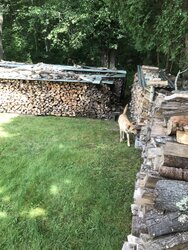The northeast has had very wet cloudy weather for a good month now. A bit of my wood is top covered, most is not. I have noticed my hardwoods appear to have taken on a bit more than just some surface moisture. For instance, some red maple previous measured at 20% is burning sluggishly-even after having been stored indoors for several days with dehumidifier going. I know softwoods can take on water but I was surprised by the hardwoods.
I will be going all top cover from here on in. Not cool.
I will be going all top cover from here on in. Not cool.
Last edited:



 There was NOTHING there as of spring of '14. May of '14 is when I placed my first log in that area.
There was NOTHING there as of spring of '14. May of '14 is when I placed my first log in that area.